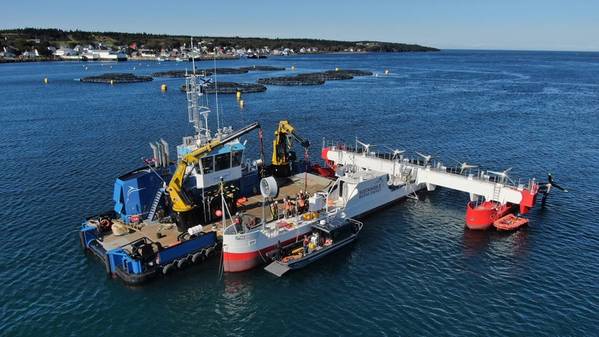
Sustainable Marine is set to demonstrate that Nova Scotia can produce vast amounts of clean and predictable energy from its world-famous tidal streams, after completing construction of its substation at Grand Passage.
“We are on target to connect the platform to the substation in the first quarter of next year,” said company CEO Jason Hayman while attending the annual Marine Renewables Canada conference in Halifax this week. “This will be a significant milestone for marine energy in Nova Scotia as it will be the first floating tidal platform to connect directly into the power grid.”
The firm has now successfully constructed an onshore electrical substation in the Bay of Fundy, which will harness the untapped power from some of the world’s highest tides via the PLAT-I tidal energy platform – which is now installed and due to be grid-connected and generating energy by early 2022.
This news comes as Sustainable Marine ramps up capacity in the province, following a multimillion-dollar investment in the most advanced marine operations support vessel of its kind on the East Coast of Canada, the Tidal Pioneer. This combined with a new recruitment drive is firmly establishing its capability to deliver turnkey solutions to support the significant international tidal and floating wind projects anticipated across the region.
Further investment in a state-of-the-art environmental monitoring program will deliver a comprehensive and robust analysis of the technology’s impact on marine life, understood at this stage to be negligible by the international scientific community.
“Nova Scotia was built with a pioneering and adventurous spirit taking full advantage of its natural resources to drive growth and prosperity,” said Hayman. “In the wake of COP26, and the global push towards net-zero we are reconnecting with those core roots to accelerate the energy transition in Atlantic Canada, helping reinforce the region’s position as a leader in marine renewable energy. Nova Scotia benefits from some of the world’s most powerful tidal energy streams, and with rapidly advancing floating offshore wind technology, there is enormous potential to transform the future energy mix from harmful diesel and coal power generation to ultra-low impact marine renewables.”
Sustainable Marine’s pioneering PLAT-I floating tidal platform has been specially designed, with significant contributions from the local Nova Scotia supply chain alongside German turbine manufacturer SCHOTTEL, to operate within the Bay of Fundy’s Minas Passage - a highly challenging and aggressive environment experiencing some of the fastest flowing tides on earth.
Currently stationed at Grand Passage, the platform is being used to deliver a rigorous environmental monitoring program, which has been underway since 2018, testing state-of-the-art underwater cameras, hydrophones, echosounders and tracking devices to record marine life interactions in the high-flow environment.
Hundreds of hours and terabytes of data have been collected and analysed to date. Sustainable Marine is also collaborating with the Ocean Tracking Network - a global aquatic research, data management and partnership organization based at Dalhousie University - and have installed two acoustic receivers on the platform to detect tagged fish. Data collected will help inform understanding of the movement of aquatic species around the system.
In addition to this comprehensive environmental monitoring effort, Sustainable Marine has engaged with Mi’kmaq community leadership and organizations. As part of the journey at Grand Passage, the team is learning about the importance of observing traditional Mi’kmaq environmental stewardship - an essential shared principle to assist coastal and remote communities in their mission to achieve net zero.
A meeting of supply chain partners was also convened by Sustainable Marine to kick off the MRC conference earlier this week which included partnership presentations from marine services companies A.F. Theriault, Ocean Sonics, and Lengkeek Vessel Engineering as well as FORCE - the Fundy Ocean Research Centre for Energy.


